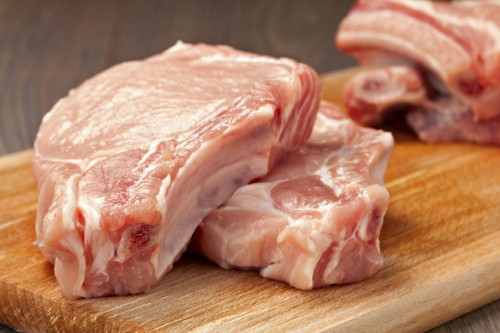
Pork is the most popular meat in East and Southeast Asia, and is also very common in the Western world. It is highly prized in Asian cuisines for its fat content and pleasant texture. The religions of Judaism and Islam, as well as some Christian denominations, forbid pork consumption; the sale of pork is illegal in many Muslim countries, particularly in those with sharia law as part of the constitution, and is severely restricted in Israel (the only country with a Jewish majority).
The pig is well known for being able to be used from nose-to-tail. There are multiple systems of naming for cuts in America, Britain, Germany, France and other countries.
Here is the 3 simple way to choose the good pork.
1.Smell the pork.
If it has neutral smell,then it is safe to eat. If it smells sour then it’s off.Pork Should be thrown out.
2.Touch the pork .
Touch the pork with your finger.If the meat is slimy or sticky ,it is no longer good.
3.check out the colour of pork.
check for discoloration.Pork should be a light reddish-pink.If you notice any other colour,it has spoiled.
Disease in pork
Vacuum packed pork loin fillets
Pork is known to carry some diseases such as pork tapeworm and trichinosis, thus uncooked or undercooked pork can be dangerous to consume, although raw pork is commonly eaten in parts of Europe
Undercooked or untreated pork may harbour pathogens, or can be recontaminated after cooking if left exposed for a long period of time. In one instance, the Food Safety and Inspection Service (FSIS) detected Listeria monocytogenes in 460 lbs of Polidori brand fully cooked pork sausage crumbles, although no one was made ill from consumption of the product. The FSIS has previously stated Listeria and other microorganisms will be “destroyed by proper handling and thorough cooking to an internal temperature of 160 �F (71 �C)” and that other microorganisms, such as E. coli, Salmonella, and Staphylococcus aureus can be found in inadequately cooked pork, poultry, and other meats. The FSIS, a part of the USDA, currently recommends cooking ground pork to 160 �F (71 �C) and whole cuts to 145 �F (63 �C) followed by a 3-minute rest.
Pigs can be carriers of various helminths, such as roundworms, pinworms, hookworms. One of the more common is Taenia solium, a type of tapeworm, which may transplant to the intestines of humans after consuming undercooked meat.[citation needed]










